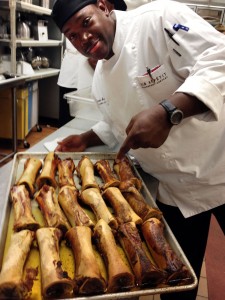Wasting Food is Not Sustainable
When my boss, Vice President of Strategy Maisie Greenawalt, asked me if I could present at the 2013 Sustainable Foods Summit on what Bon Appétit is doing to combat waste in the food system, I thought, “Oh boy, I need to do some research!”
I am a lover of leftovers and live in Portland, OR, where the city makes it easy to compost, but I certainly wouldn’t think of myself as an expert on food waste. Until recently I thought a biodegradable to-go box was always compostable (turns out that’s not the case), and I’m definitely guilty of letting bunches of herbs and other produce wilt away in my veggie bin.
So I turned to the experts: Jonathan Bloom, author of American Wasteland, and Dana Gunders, author of a paper on food waste for the National Resource Defense Council.
From them, I learned that 40% of food in the United States goes uneaten. Just so we’re clear, that’s nearly half. Yet one in every six Americans — or about 50.1 million people, a good portion of whom are children and senior citizens — lacks a secure supply of food. All that food waste we send to our landfills accounts for almost 25% of U.S. emissions of methane, the greenhouse gas contributing to climate change that is 20 to 25 times more powerful than carbon dioxide. Waste is happening at every part of the supply chain: thousands of pounds of fresh vegetables are being left in the fields to rot, blemished produce are being tossed at our supermarkets, restaurants are dumping perfectly good leftovers, and consumers are letting food waste away in their refrigerators. Clearly, we have a problem.

University of Pennsylvania Executive Chef Christopher Smith with the roasted bones he uses to make beef stock from scratch.
The best way to address food waste is to stop it from happening in the first place. As I talked to Bon Appétit Management Company staff, I learned that preventing waste is at the heart of how we operate as a food service provider. All of our chefs cook from scratch using fresh, local, and seasonal products. We encourage snout-to-tail and stem-to-root cooking by making all of our own stocks and soups — great destinations for bones and vegetable trimmings.
We also hold a number of educational and awareness-raising events in our cafés. Every year we celebrate Low Carbon Diet Day, about how our food choices affect climate change. Making people aware of food waste is a big part of that program: the teams set up visual displays of a day’s worth of food waste or have guests empty their leftovers into clear bins that show the accumulation of waste over a week’s time. Most consumers are shocked, and these events help them recognize the important part we all play in addressing this problem.
Still, some food waste is inevitable, and so we also work hard to keep it out of the landfill, through composting, feeding food scraps to pigs and other livestock, and converting the food waste to energy (for example, through the biodiesel that runs my colleague Piper’s car).
Some of the food that would otherwise go to the landfill is high-quality, untouched items, for example from over-generous catered events. Finding ways to get this food to people in need within our communities is one of the most rewarding ways to decrease food waste.
Devi Raja from Feeding America said that theoretically, we need just 5 billion pounds of food to eliminate hunger in the United States, and 20 billion pounds of edible food is being thrown away by restaurants and convenience stores each year. While composting is great for inedible scraps, there is no reason we should be sending perfectly good food to the compost bin or the landfill if it can be used to feed a person in need!
Bon Appétit already has food recovery programs at many of its accounts. Most recently, Whittier College in Southern California got a program in place with the help of a few dedicated students, Bon Appétit staff, and the Food Recovery Network. Food recovery takes very little effort, builds great relationships with our community and guests, and keeps perfectly good food out of our landfills. There is no reason why more businesses shouldn’t be doing this.
I shared these Bon Appétit Management Company efforts at the summit. That day, I also learned how badly the world needs a successful widespread campaign and concerted effort to educate people about the issues with waste in the food system. It is critical that we all take responsibility for how our actions affect our environment and the health of our communities.
On the same day Florence Rolle from the Food and Agriculture Organization of the United Nations (FAO) spoke to summit participants about waste in the food system, the FAO and Messe Düsseldorf launched a Think, Eat, Save initiative to change the global culture of food waste! I am hopeful that as this campaign grows, there will be more opportunities to work together to brainstorm and adopt solutions. I am excited about the Campus Food Waste Summit at Stanford in April, since it will be the first time that students, food donors, and entrepreneurs from around the country will meet to creatively think about solutions to waste in the food system.
Food waste is a very real issue, with a number of easy, fun, and simple solutions. It will take all of us along the food chain (farmers, distributors, grocery stores, restaurants, consumers) to make a lasting change. Jonathan Bloom, who moderated my panel at the summit, asked us what our one wish to solve this problem would be. Mine was for all of us to stop wishing and start doing.
I hope you will ask yourself: What’s the first step I can take to reduce the amount of food I waste?

